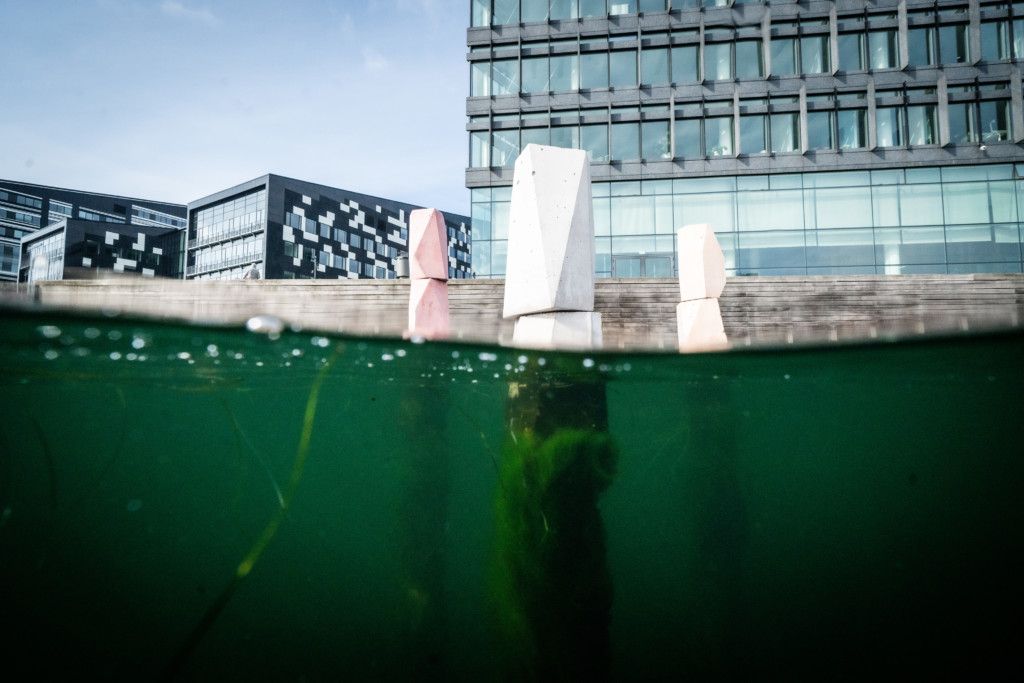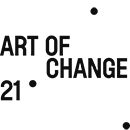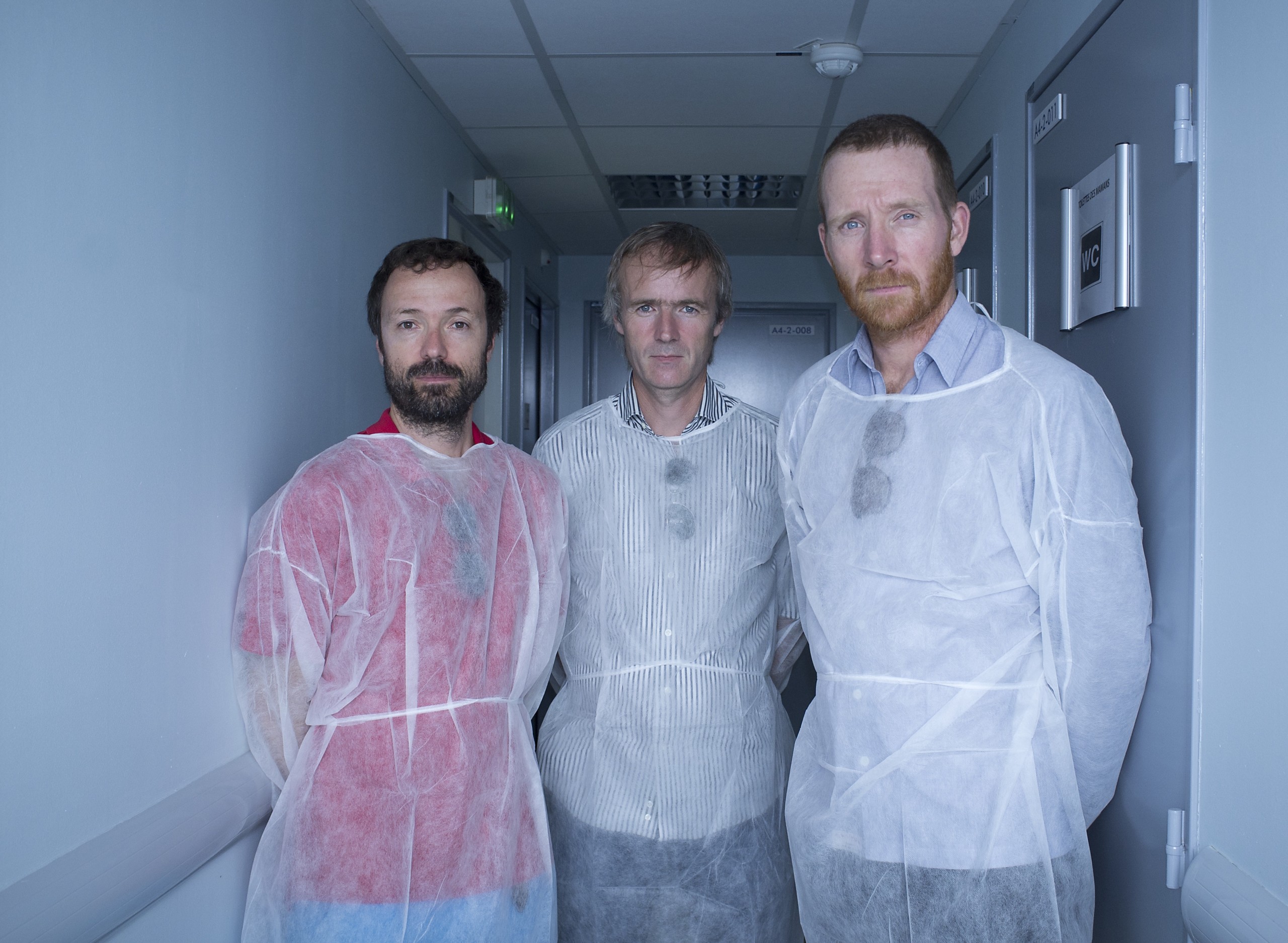Founded in 1993, Danish artist group SUPERFLEX live and work in Copenhagen. In this interview, co-founder Jakob Fenger explains how SUPERFLEX’s art transcends traditional boundaries and even exploits humour to spark change and inspire a more sustainable future.
Stefano Vendramin: SUPERFLEX has been addressing environmental issues through varied projects over almost 30 years, such as the biogas system Supergas (1996-7), the video work Flooded McDonald’s (2009), and sculptures doubling as potential homes for fish (As Close As We Get, 2021). Can you share the thought process behind these diverse responses to environmental concerns?
Jakob Fenger: Our journey started with a techno-centric creation, Supergas, aiming to directly address environmental challenges by creating a mobile, decentralised biogas system that would reduce pollution and make communities self-sufficient, particularly in the Global South. Despite its potential, after many years working on it, the difficulties we had funding the project led us to rethink our approach. We decided to make it open source, so on the positive side, there are still people making them by themselves, but we were forced to abandon it. The experience, particularly the scepticism we faced, was a turning point.
You can see Flooded McDonald’s as a reaction to that. It’s about accepting that things are moving in a certain direction, and that we can’t control that direction. In the film, you don’t know where the rising water is coming from and why. However, what you see is that one of the peaks of our civilization, in this case a fast-food restaurant, is being slowly dissolved into this murky, brownish water that gets more and more filthy as the flood rises.

Left : Supergas. , Right : Flooded McDonald’s, 2009. RED, 21 min. Still Image. Photo: SUPERFLEX
Today, we know we cannot control things, but can we make a society that is more inclusive? In the anthropocene, humans – you and me – are the ones designing this world, but maybe we should start to understand ‘the other’, for example the fish and other sea creatures that will remain even if we erase ourselves, when we make these decisions?
Therefore the movement of our work has been from this idea of “let’s just fix the human problem, and then we’ll be okay”, to acknowledging how hard that is, accepting the dissolvement of our world, and starting to acknowledge this ‘other’ that comes with the rising water or comes with the changing weather, that is living around us, and that we should consider them as partners.
Therefore, our work has evolved a lot. It has gone from this idea of “let’s just fix the human problem, and then we’ll be okay”, to acknowledging how hard that is. Recognising our powerlessness in the face of the dissolution of our world, we want to connect with the so-called “other”, the living beings around us whom we should consider as partners and who are also experiencing the rising sea levels and global warming.

Beyond The End Of The World, 2021. Still image. Photo: SUPERFLEX
Your new solo exhibition at ICA San Diego, ‘Beyond the End of the World,’ opened in January 2024, seems to reflect a pessimistic view on climate change. Is this a real concern or more of a provocation?
The exhibition, divided into two spaces, starts with a film in which you see the toilets being flooded in the UN Climate Change (UNFCCC) headquarters in Bonn, Germany. There are no more humans but you can see the fungus and algae starting to take over.
In the film’s second part, you see a dog walking around the remains of a building. The dog looks almost wolf-like, as if representing a bridge between humankind and the ‘other’, represented here by the algae. In the background we hear a stretched version of “Cry me a river” by Justin Timberlake, a breakup song.
The song follows you into the second space, where you see different parts of the toilet from the first video – a faucet, paper roll, etc. – but this time made out of un-fired clay. We chose this material because it’s taken from the earth, and we will give it back to the earth. Being very fragile, you cannot ship it around, so it will stay here in San Diego and it will disappear here, which makes it very symbolic.
This exhibition is obviously using humour as a form of provocation, hence the toilet as a subject. Moreover, the clay sculptures are ironically entitled “Power Toilet Death Masks” referring to the mementos of the dead that bear a likeness of a person’s face after their death, usually made by taking a cast or impression from the corpse. Finally, making clay fixtures for a toilet makes absolutely no sense because if you ever used them, they would disappear.
On the other hand, it’s also interrogating the idea that what we have, we might lose. Just like Flooded McDonald’s, it’s about going over the border and seeing what it’s like on the other side.
I think many people are trying to be positive, and I think that’s good too. But sometimes you need to go to a dark place to see the light. Art is sort of the space where you can and have to create some conflict or contrast, to challenge the existing system.

Power Toilet Death Masks, 2024. Photo: SUPERFLEX
What do you think the role of artists today should be in terms of climate change and the environmental issues that are surrounding us?
I would not be the one to demand or to wish for other artists to do this and that, but we are facing an existential crisis, and we need all means possible to overcome it, or to at least acknowledge and work with it. I think art can play a large role here, as much as science and engineering. We are not activists because there’s activists out there that do a great job, and we don’t pretend to be like them. But you could say that we are activists within the art space. That’s where we try to move things.
In our current context, it’s not enough to make new guidelines and listen to numbers. You also need a more emotional, mindful approach to things, where you stop for a second and think about where you are, how you are doing and where we’re going.
As artists we can take people to a dark place, like we do at the ICA exhibition, and then hopefully our audience will see the light at the end of the tunnel. We can be a part of changing minds in order to change the reality.
SUPERFLEX is of course a collective. Is it something that you would recommend to other artists?
Definitely. Humans are a social species, and we work really well when we do things collectively. Even if you’re a solo artist and you do your own things, you still usually work with other people. I think when we face huge problems, it’s when we cannot achieve that. So the collective is also the key to solving many issues that we are facing in this world.
You mentioned already that in Beyond the End of the World, the clay artworks will go back to the soil, and of course, video is already a very “light” medium for far-away exhibitions. Is Superflex doing anything else regarding the sustainability of your studio practice?
About five years ago, we hired someone to look at our system, and we learned a lot from that. We never spoke publicly about it, but we felt that it was necessary to do. If you don’t know what the numbers actually are, then it’s very hard to act in a good way. He looked at our CO2 emissions and it was crazy how much of it was due to shipping artworks. What happens most of the time when you work with galleries and art fairs, they ship things last minute and so they fly stuff. I think not many artists and galleries are aware how big a problem this is.
We figured out that if the people we work with can tell us three or four weeks in advance what they want, we can ship things differently, and it cuts our total emissions about 40%. We now ask this of all the galleries we work with.

As Close As We Get by SUPERFLEX 2022. In collaboration with DTU Sustain and By & Havn. Supported by @statenskunstfond. Photo by: Lars Hestbæk
What are you working on at the moment?
Our dream project at the moment is to build a reef around Denmark, a “Super reef”, which attempts to recreate a habitat for marine flora and fauna where humans had previously removed them.
We did a first experiment in the harbour of Copenhagen, collaborating with scientists to create different shaped objects that we put in the water to see what the fish liked best. For the lab, they served as tests to do research on the material in contact with the ocean, and for us it served as a sculpture. We really like to do these kinds of collaborations where other professions get something out of it as well, and we use knowledge from different groups, benefiting from everybody’s particular skillset, whether technician, scientist or us as artists.
It’s one of these huge, crazy, impossible projects that you have to throw out there to make things move. But we are actively trying to make it happen.
SUPERFLEX: Beyond the End of the World is on show at ICA San Diego until July 28, 2024.
Conversation with Stefano Vendramin
January 2024
Learn more about SUPERFLEX
Cover : SUPERFLEX: (From left) Bjørnstjerne Christiansen, Rasmus Nielsen, Jakob Fenger. Photo: SUPERFLEX
Impact Art News, Jan-Feb 2024 #47
Subscribe to Impact Art News (free)

